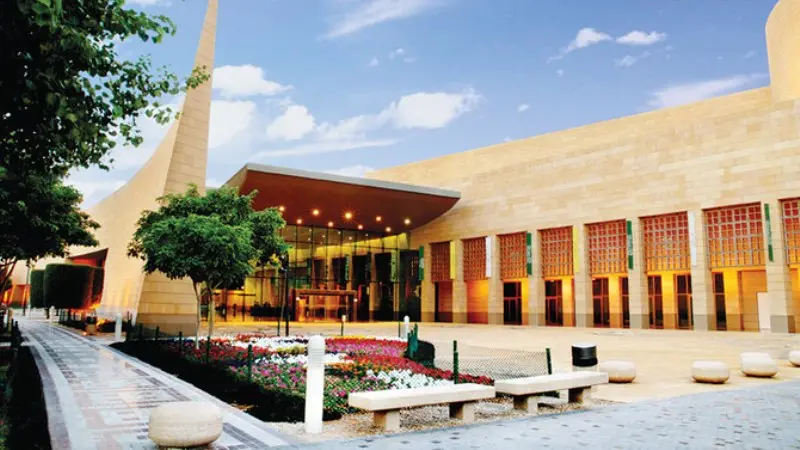The National Museum of Saudi Arabia, situated in the heart of Riyadh, the nation’s capital, stands as a testament to the rich and varied history of this ancient land. It is a museum of international standing, unveiling the secrets of a country known for its captivating landscapes, historic sites, and vibrant culture.
This article will delve into the museum’s history, reasons to visit, its location and route, the best time to visit, and the prime attractions to see.
History
The National Museum of Saudi Arabia was inaugurated in 1999 as a part of King Abdulaziz Historical Center, named after the founder of the Kingdom of Saudi Arabia, King Abdulaziz Al Saud. It was established to preserve, display, and interpret the country’s historical and cultural heritage.
The museum, designed by Canadian architect Raymond Moriyama, is an impressive eight-gallery marvel covering an area of 28,000 square meters, chronologically arranged to showcase over 2,000 artifacts.
Why Visit?
The National Museum of Saudi Arabia offers a unique opportunity to explore and understand the cultural, historical, and social evolution of the Arabian Peninsula, from prehistoric times to the present day. It houses a fascinating collection that includes ancient manuscripts, crafts, coins, clothes, and monumental statues, among other artifacts.
The architecture itself is a compelling reason to visit, with a design that mirrors the undulating sand dunes typical of the Arabian deserts and combines elements of traditional Arab architecture with modern design. The museum offers interactive displays and audio-visual tools, catering to all ages and languages, making it a significant educational hub for students and researchers alike.
Moreover, the museum’s international standing is reflected in its active participation in worldwide archaeological missions and exhibitions, and collaborations with globally recognized museums and cultural institutions. By visiting the museum, one doesn’t only see Saudi Arabia’s history and culture but also its global connections and contributions.
Location and Route
The National Museum of Saudi Arabia is conveniently located on King Abdulaziz Historical Center’s premises, on King Abdulaziz Road, Murabba district, Riyadh.
For travelers coming from King Khalid International Airport, it takes approximately 40 minutes by car via the Riyadh – Al Kharj Hwy/Road 5. Alternatively, visitors can use the Riyadh Metro, getting off at the Qasr Al-Hokm Downtown Metro Station, which is a short walk away from the museum.
When to Visit?
The museum is open all year round, except for certain public holidays. The best time to visit Riyadh, and subsequently the National Museum, is during the cooler months between November and March, when the scorching summer heat subsides. The museum operates from Sunday to Saturday, with varied timings. Fridays are shorter days, so planning a visit earlier in the week would allow for a more leisurely exploration.
What to See?
Visitors will embark on a journey through time as they navigate through the eight chronological galleries:
- Man and Universe Gallery: Learn about the Arabian Peninsula’s formation, its geological features, and the earliest signs of life.
- Arabian Kingdoms Gallery: Explore the ancient kingdoms, their trade routes, and the development of writing.
- Pre-Islamic Era Gallery: This gallery illustrates the cultural and economic development leading up to the advent of Islam.
- Prophet’s Mission Gallery: Gain insights into the life of Prophet Muhammad and the birth of Islam.
- Islam and the Arabian Peninsula Gallery: Delve into the expansion of Islam across the Arabian Peninsula.
- First and Second Saudi State Gallery: Learn about the formation of the first and second Saudi states.
- Unification of the Kingdom Gallery: This gallery sheds light on the unification process of Saudi Arabia.
- The Kingdom in the World Today: Explore the modern-day achievements of Saudi Arabia and its contributions globally.
The National Museum also boasts a vast outdoor exhibit with a full-scale reproduction of the Nabataean tombs of Madain Salih, a UNESCO World Heritage site, and other archaeological sites of significance.
In conclusion, a visit to the National Museum of Saudi Arabia is a journey into the heart of a kingdom whose history is as old as time itself. The museum elegantly combines education and entertainment, making it a must-visit destination for history enthusiasts, researchers, and anyone interested in understanding the ethos of the Arabian Peninsula. It offers its visitors a unique blend of the past and present, providing an immersive experience that continues to captivate hearts and minds.
